In February 1972, the Shanghai Communiqué (also known as the Joint Communiqué of the United States of America and the People’s Republic of China) was issued at the Grand Hall of Shanghai Jinjiang Hotel. 47 years later, on July 6, 2019, people gathered in the hall, recalling the moment that opened a significant chapter in Sino-US relations.
To commemorate the 40th Anniversary of China-US Diplomatic Relations, a city journey themed “Trans-Pacific Exchange and Cooperation” was joined by over fifty participants on July 6, who followed two routes across the city and traced the historic moments linking China and the US.

(The opening ceremony of the city journey was held at the Grand Hall of Shanghai Jinjiang Hotel.)

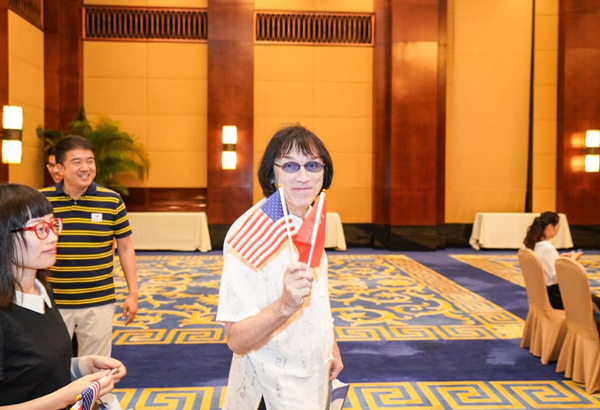
Divided into two groups, the participants were composed of guests from both China and the US, along with media reporters. The journey started at the Grand Hall of Shanghai Jinjiang Hotel. According to Cheng Ronggen, apart from Richard Nixon, Dr. Henry Kissinger and Jimmy Carter have also been to the hotel.
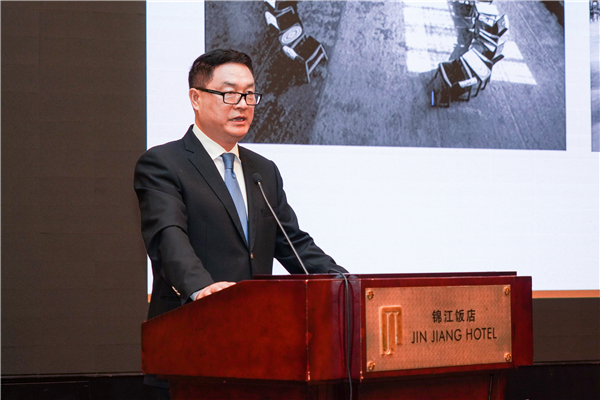
(Cheng Ronggen, a witness to Richard Nixon’s visit in Shanghai in April 1993)
Over the past decades, the exchanges between Chinese and American people have never stopped. In Shanghai, for instance, many buildings across the city crystallize the work and wisdom of American designers, including the Shanghai Center on West Nanjing Road. Designed by American architect John C. Portman Jr., it hosts apartment units, a high-end office area, a supermarket, department stores, a theatre, and a five-star hotel.
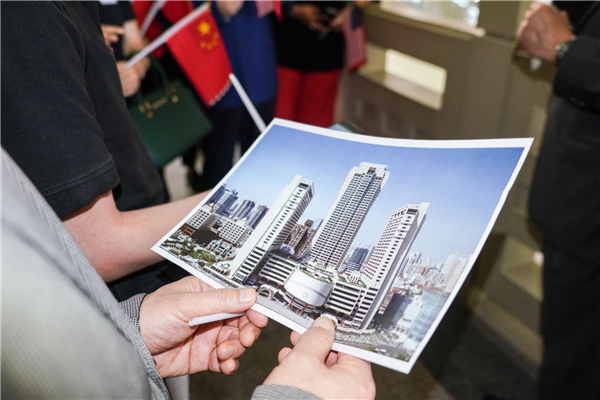
(A picture of the Shanghai Center)
“I’ve been here many times,” said Marshall Strabala, chief architect of the revolutionary Shanghai Tower. In his eyes, though it was built in 1990, the Shanghai Center is a modern building. During the journey, he and the other visitors were impressed by the design of the building, which is a fusion of East and West. Its structure is similar to that of the Palace Museum in Beijing. Dougong (interlocking wooden brackets) are an important element in traditional Chinese architecture, and can be found in the majestic building, which interestingly has lamps in it, making the building glow with traditional beauty at night.
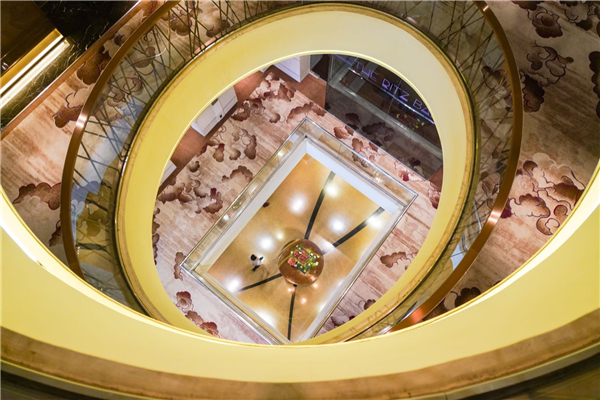

(Visitors listen to the story of Portman Ritz-Carlton, Shanghai, at the Shanghai Center.)
The participants also visited Shanghai Library, Fudan University, the Shanghai Securities Museum (formerly the Astor House Hotel), the World of Coca-Cola Shanghai, Cadillac House, the Shanghai Science and Technology Museum and the Shanghai Disney Flagship Store.
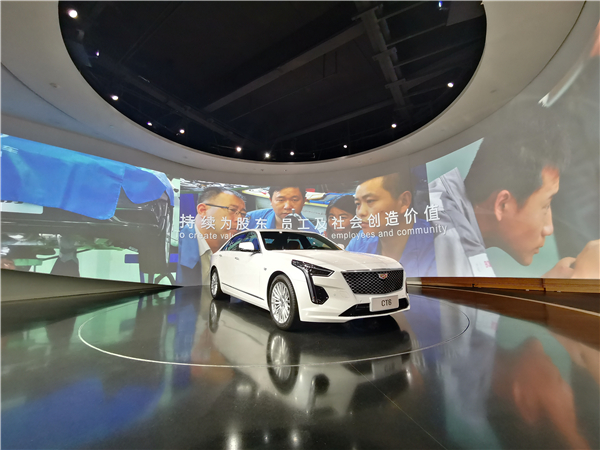
(A car exhibited at the Cadillac House)

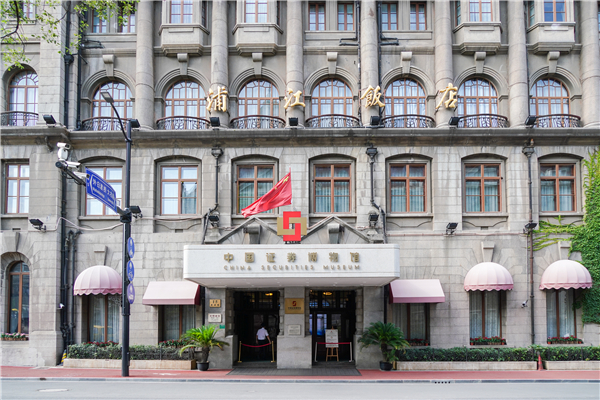
(The China Securities Museum was opened in century-old Astor House Hotel last December.)
At the Shanghai Science and Technology Museum, after watching an exhibition showing how plastics damage the Earth’s ecosystems, Michael Rosenthal, president of US Green Solutions.com, who provides eco-friendly solutions to companies, said, “This exhibition is 100 percent related to my industry. It’s terrible that we create plastics every day. Plastics bring tragedy to fish and there is even plastic in fish’s biological structure.”
For Phillip Jarrell, a musician, designer, photographer and artist living in Shanghai for over ten years, today’s journey was informative. He had been to Fudan University before, but it was the first time for him to learn the history of the university, especially the story of Madame Xie Xide, the first female university president after the founding of New China, as well as many important meetings hosted by China to talk about the development of China-US relations. The visit to the Center for American Studies of Fudan University also brought to mind current China-US relations. For him, dialogue is significant, for the sake of better understanding.

(Phillip Jarrell takes a picture at the Center for American Studies of Fudan University.)
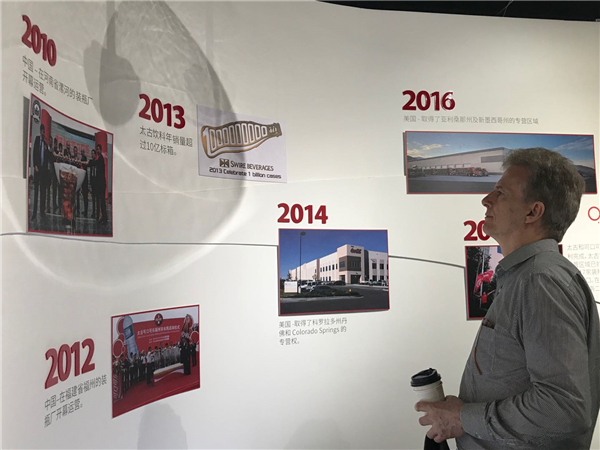
(Stephen White visits the World of Coca-Cola Shanghai.)
At Coca-Cola Shanghai, Stephen White, general manager of Iaction, said, “This event is interesting. We have recalled the history and learned about China and Shanghai through Coca-Cola. This commemoration activity is one of many exchanges between the US and China. It’s very successful.”
The journey culminated at the last stop, the Shanghai Municipal Archives on the Bund, where the visitors watched a picture exhibition featuring over 300 photos documenting the exchange and cooperation between Shanghai and the United States of America, since the issuance of the Shanghai Communiqué.

(Michael Rosenthal)
Pointing to the photo showing Zhou Enlai and Richard Nixon raising glasses in celebration of the issuance of the Shanghai Communiqué, Michael Rosenthal said, “This is the most important one. Our relations started here. Under the leadership of Deng Xiaoping, there were tremendous cooperations between the two countries. When countries have a better understanding of each other, they start doing things together and are more tied to their joint future, which means reducing the chance of conflict.”
Guided by the Chinese People’s Association for Friendship with Foreign Countries, the event “Trans-Pacific Exchange and Cooperation--Shanghai Commemorates the 40th Anniversary of China-US Diplomatic Relations through a City Journey” was hosted by Eastday and the Shanghai People’s Association for Friendship with Foreign Countries (SPAFFC).
Click to see more about the journey:
https://a8.rabbitpre.com/m2/aUe1ZjLsdp?lc=2&sui=f26d10ac-8cff-40a3-a3df-6842bab77c38#156229565093230
(Story by Wu Qiong, Zheng Qian, Lu Yukun)
(Photos by Wang Weiqiu, Liu Hao, Zheng Qian, Wu Qiong)
